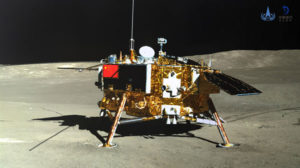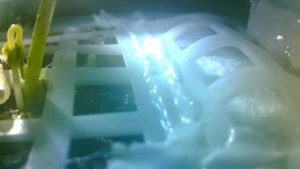With a seed germinated on the lunar farside, Earth’s biosphere made its first tentative foray into the cosmos.

AFP / Getty Images
In January the Chinese space agency achieved an impressive first, landing Chang’e 4, which also held the Jade Rabbit 2 rover, on the lunar farside. One of the most sensational image releases from this mission showed germinating cotton seeds growing inside the lander.
These aren’t the first plants raised in space. Astronauts have long used the International Space Station, for example, for biological experimentation, including studies of how plants grow when subjected to low gravity and radiation. But there’s symbolic potency in the first plants (that we know of) born on the surface of another world. Call it one small step for plantkind.
Yet these organisms couldn’t have achieved this by themselves, so this is really another small step for humankind. It may not be a giant leap, but if humans are ever to go and live elsewhere in the solar system, not just for a visit but to remain, we’ll have to take our biospheres with us and learn how to tend them there.
Among the experiments onboard Chang’e 4 is the apparatus that contained the cotton seeds — the Lunar Micro Ecosystem (LME). It also carried seeds of several other kinds of plants as well as yeast and fruit fly eggs. The plan was to keep the receptacle at Earth-like temperatures for 100 days while the plants sprouted and the flies hatched, setting up a miniature ecosystem in which the animals respired and the vegetation photosynthesized, exchanging oxygen and carbon dioxide like a mini-Gaia.

Chonqing University / AFP / Getty Images
The experiment didn’t go as hoped. The cotton seeds did sprout, providing an inspiring photo-op, but they didn’t survive the coming of night. Unfortunately, during that first long, frozen lunar night, the LME’s thermal control failed, and the young sprouts, along with the still-unhatched flies, froze to death.
While it’s true that plants can’t go to the Moon or Mars without us, it’s also true that we can’t go to Mars — at least to stay — without plants and myriad other living things. If we want to survive we’ll need to learn how to keep our nonhuman companions happy.
One famous experiment attempted along these lines in the early 1990s was Biosphere 2. An enclosed habitat in the Arizona desert, Biosphere 2 bore a complement of species meant to simulate a range of terrestrial ecosystems. These microhabitats would recycle gases, water, and nutrients in order to keep the enclosure’s humans and other beings alive.
The exercise failed when runaway growth of some species, die-offs of others, and dangerous changes in the O2 and CO2 levels meant that the human “biospherians” could not safely remain inside. Fortunately, it was easy to abandon ship, as this experiment was here and not on Mars.
Today, Biosphere 2 serves as a teaching and research facility, and studies involving enclosed people are no longer attempted there. Recently I got a tour, and it’s a fascinating time capsule — a vision of the future fading into the past. But it’s also a monument to both arrogance and humility, a lasting lesson in what can go wrong when we think we know more than we do. Our planet’s environment maintains the complex balance of life so gracefully that it’s easy to take for granted.
Like Biosphere 2, the Chinese trial is a sobering reminder that we still have an awful lot to learn about life and its mutual dependencies if we want to someday go and live beyond our home biosphere. Raising a plant on the Moon, even for a brief time, is a welcome tiptoe in that direction.
This article originally appeared in print in the May 2019 issue of Sky & Telescope.
 1
1
Comments
Bob
June 2, 2019 at 10:15 am
"We still have an awful lot to learn about life and its mutual dependencies....
I could not agree more.
You must be logged in to post a comment.
You must be logged in to post a comment.